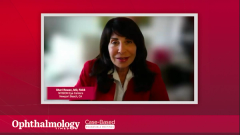
The Impressions and Takeaways from Patient Case No. 1
An expert discusses the key considerations for addressing dry eye in a patient who has undergone multiple ocular procedures.
Sheri Rowen, MD, FACS: When you think about it, we’re wondering: What are the key considerations for managing dry eye and this patient? There are a lot of things to think about. We have meibomian gland dysfunction. She didn’t have a very good tear film, so we certainly didn’t even have good tears. So I wanted to increase her tear formation. We could not do this with the cyclosporine drops because they burned and irritated her too much. So the varenicline [Tyrvaya] really has been very helpful for her because she can produce her natural tears without it irritating her eyes. We got tear formation with that. With the Meibo, we noted in study [that] she was able to be much more comfortable because that helped to prevent the evaporation. So these 2 drops together, or drops of spray for the Tyrvaya and the drop for Meibo, really are what she is going to require going forward. And as we know, dry eye is such a multifactorial disease that each patient may require something different. When they cannot take the drops that we’d like to give them—an immunomodulator to cut down their inflammation because it burns and stings—we can go to the Tyrvaya to be able to apply it away from the eye but get more tears. We can also put Meibo in, which will prevent evaporation. And when you think about a case like this, there are so many factors. She’s had multiple surgeries, she’s had LASIK [laser in situ keratomileusis], PRK [photorefractive keratectomy], she’s had crosslinking, and now she’s had cataract surgery. And we’ve been able to rehabilitate her so she’s functional, she feels OK, she looks better, she’s less red. She can see better now because we’ve eliminated the visual impairment of having cataracts. And we were able to correct that astigmatism with the light-adjustable lens. And so that’s kind of how I’m thinking about the treatment for a patient like this. And I think in our roundtable, most of the doctors totally agreed with this because many are specialty contact lens fitters. A lot of our doctors there saw a lot of preoperative surgical patients. And we have to think about those things. When we’re treating a patient like this, we have to optimize their surface so that we can operate on them when they need it and figure out ways for them to see so that we don’t have to add insult to the injury that’s already been created. So that’s my takeaway on case 1.
Transcript is AI-generated and edited for clarity and readability.
Newsletter
Don’t miss out—get Ophthalmology Times updates on the latest clinical advancements and expert interviews, straight to your inbox.















































.png)


